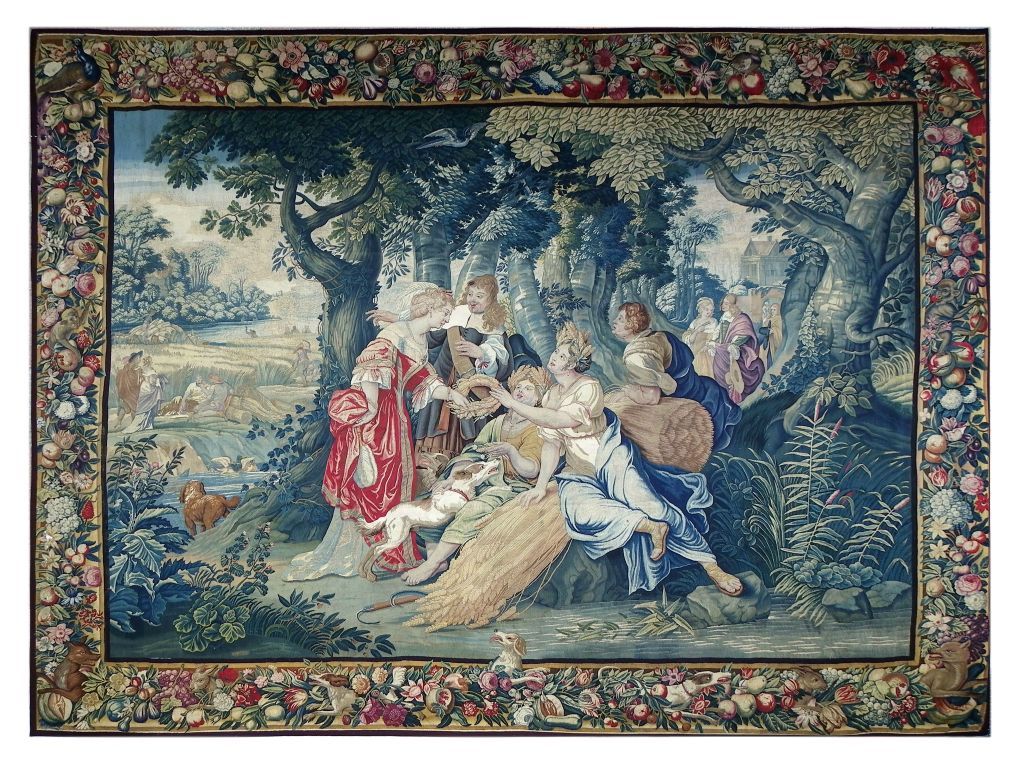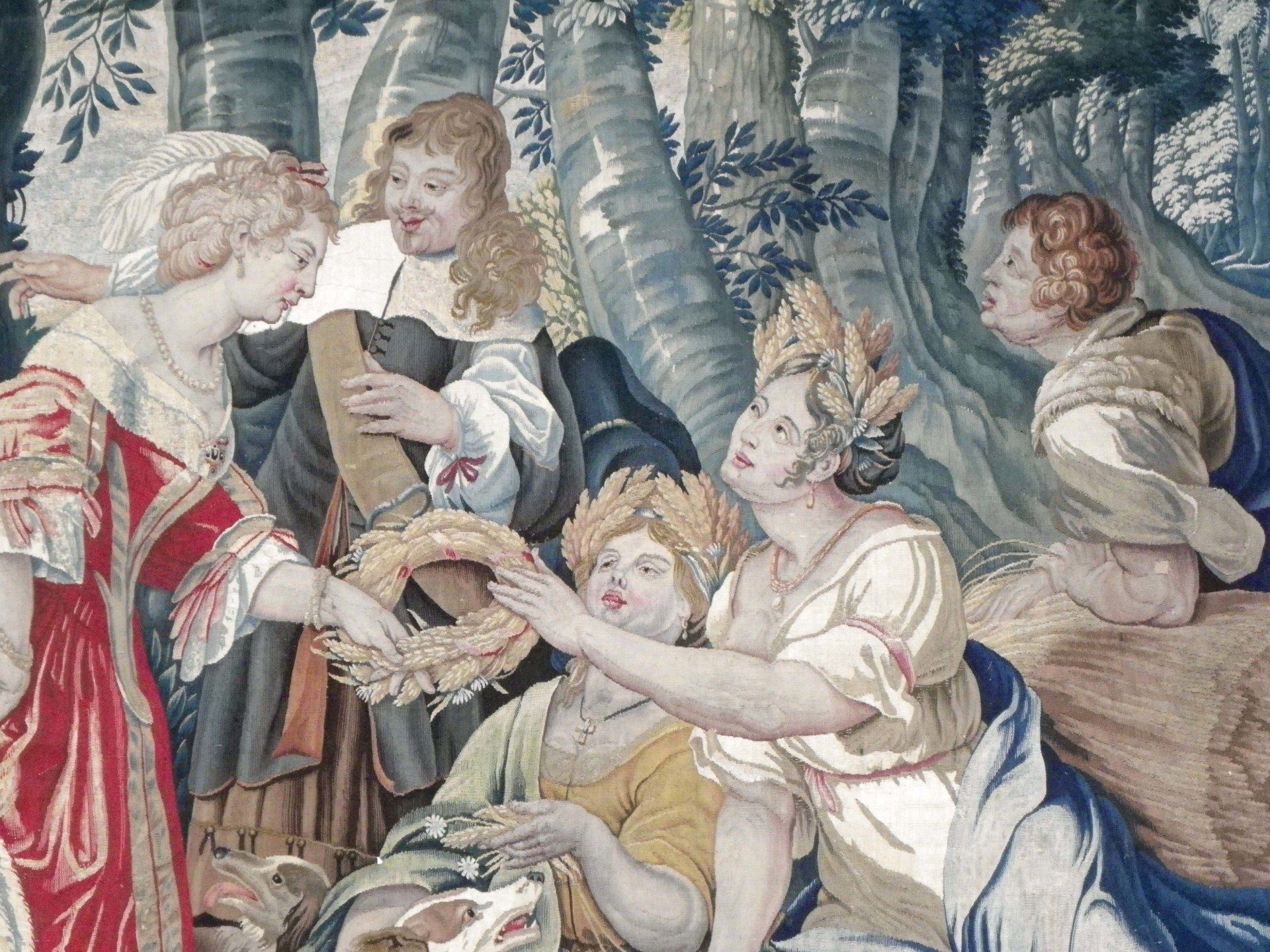Flemish tapestry | Landscape - historical | Purchase Sale
Flemish tapestry - Anvers
Collection Galerie Jabert Collection: Summer and Harvest - The Goddess Ceres with her daughter Proserpine.
Very fine 17th century tapestry panel, woven in one of the many workshops in Antwerp (Flanders) which worked mainly for export. The panel that we present here is exceptional, keeping the freshness of all its colours as in the early days. This tapestry is for registering the summer with the harvests and is part of a series of four-panel hangings on the theme of the four seasons. The composition of the cardboard inclines us to suggest that it is probably a work by Jan Wildens (1586-1653). A rich, in places collaborative border of flowers and fruit, with a small dog at the bottom in the centre (a peculiarity of some Antwerp workshops), pleasantly enhances the high quality of this tapestry.
Analysis of the panel composition
The structure of the composition of the characters suggests a double interpretation, one mythological with the Goddess Ceres (or Demeter for the Greeks) and her daughter Proserpine (or Persephone for the Greeks), and the other more contemporary at the time the tapestry was made. If the women's dress subodorizes that the commissioner of this tapestry may be a follower of the rigour demanded by the "Reformed" church, the hat in the hands of one of the characters in the background in the centre invites us to believe it.
To the left of the panel where can be seen the harvesters working in the fields, mowing and tying the bales of wheat. Characters from the central scene, on the left the Goddess Ceres dressed in red her tutelary colour, in front of her her daughter, Proserpine, lying on the sheaves and a gallant bourgeois in the background, two other young women to whom Ceres presents crowns of wheat, symbol of fertility and fecundity.
Mythological background
In Sicily, every year, in commemoration of Ceres' departure for his long journeys. The islanders, neighbours of the volcano Etna, would run at night with lit torches and shouting loudly.
These feasts were later introduced in Rome, in the form of processions around the fields, the Ambarvales celebrated by the Arvales Brothers: they were celebrated by the Roman ladies dressed in white. Even the men, simple spectators, dressed in white. It was believed that these feasts, in order to be pleasing to the goddess, were not to be celebrated by people in mourning. For this reason, they were omitted in the year of the Battle of Cannes.
In addition to the pig, sow or cow, Ceres also accepted the ram as a victim. In his solemnities, the garlands used were of myrtle or narcissus; but flowers were forbidden, because it was by picking flowers that Proserpine had been taken away by Pluto. The poppy alone was consecrated to him, not only because it grows in the midst of the wheat, but also because Jupiter fed it to him to give him sleep, and therefore some respite from his pain.
Ceres has an only daughter, with Jupiter, king of the gods. Her name is Proserpine, assimilated to the Persephone of the Greeks. But while her daughter was picking flowers with her friends, she was taken by the god of the underworld, Pluto. Ceres did not recover and stopped farming. She went to inquire about the divine judgment of Jupiter, who ordered Proserpine to spend the winter in the Underworld and the rest of the year with her mother.
Sources: History of tapestry from the Middle Ages to the present day Guyffrei 1896
Dictionary of symbols, myths, dreams, customs, gestures, shapes, figures, colours, numbers. Coll. BOUQUINS, Edt Robert Laffont/Jupiter. Jean Chevalier1987.
History of Antwerp Tapestry
For a long time, the upholsterers of Arras or Tournai were the most productive. Tournai was a city of French political obedience until 1521. The first mentions of upholsterers in Tournai date back to 1295. The tapestry workshops of Tournai produced important historiated hangings illustrating the same subject of biblical, historical, mythological or romantic inspiration, taking up the chivalrous ideals of the court of Burgundy. In 1448, Philippe le Bon commissioned the hanging of the History of Gédéon or the Golden Fleece to be delivered in four years, and which was, according to Eugène Soil, "the most famous piece to come out of the workshops in Tournai".1 Around 1530, Tournai, which had taken over the first place in Arras in the production of tapestries, saw new competitors develop, Brussels, Lille, etc. The production of tapestries will stop in Tournai in 1720.
The importance of the Arras tapestries can be seen in the name "arazzo" or "arrazzy" used in Italy or Poland, "drap de Ras" in Spain to designate the tapestries, long after Arras had lost its predominance. The decadence of Arras began when, in 1398, the Duke of Burgundy, Philip the Good, decided, in order to redress the city's finances, to double the tax on the high hills. Merchants and tapestry workers then began to leave the city to settle in Tournai, Lille, Oudenaarde, then Brussels and Bruges2. As early as 1449, Duke Philip the Good preferred to order the hanging of the story of Gideon in Tournai rather than in Arras. In 1456, the bourgeois of Arras complained to the Duke of Burgundy that the workers in Haute-Lisse were leaving Arras to settle in Valenciennes, Tournai, Bergues and other towns. Arras then lost the duke's orders. Charles the Bold's demands for money to finance the war began to ruin the city3. The conquest of Arras by Louis XI led to the relocation of the tapestry workshops to the Habsburg Netherlands in 1477, and the control of Brussels by the House of Habsburg and the difficulties of Arras allowed the development of production in Brussels.
At the beginning of the 16th century, the rise to the main thrones of Europe of sovereigns enamoured of grandeur, and in the Netherlands of regents passionate about tapestry, was to be the source of rivalry between the various royal and princely courts to possess the most beautiful tapestries, which was favourable to the Brussels workshops which employed up to 15,000 people in the 16th century.
A regulation of 1476 stipulated that only painters were allowed to design the models of the tapestries, unless they were green.
Tapestry Antwerp| Achat Vente Expertise | Paris
Brand of the Brussels Tapestry
In order to combat counterfeiting, the marks of the city of Brussels and of the tapestry workshops were made compulsory on tapestries by an order of the Brussels magistrate issued on 16 May 1528 for each tapestry of more than 6 aunes. This obligation was repeated in the imperial edict of 16 May 1544 concerning the organisation of the tapestry industry. The mark of Brussels is made of a small red shield flanked on both sides by capital letters B for Brabant Brussels. The monogram of the lissier had to be deposited in a register of the corporation. This document was destroyed in a fire in 1690.




